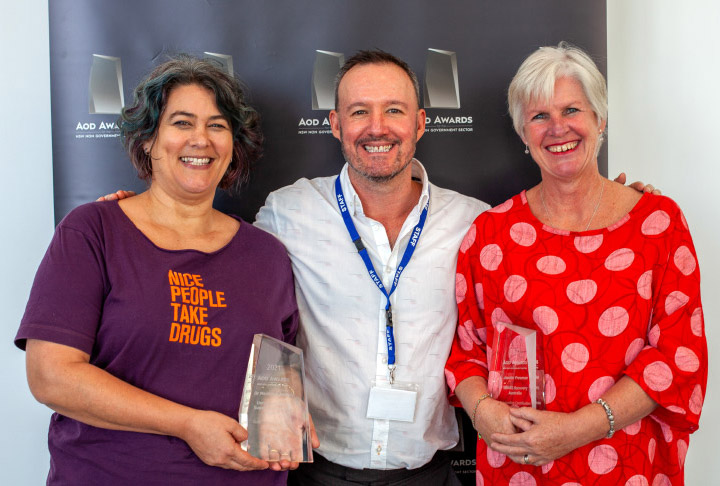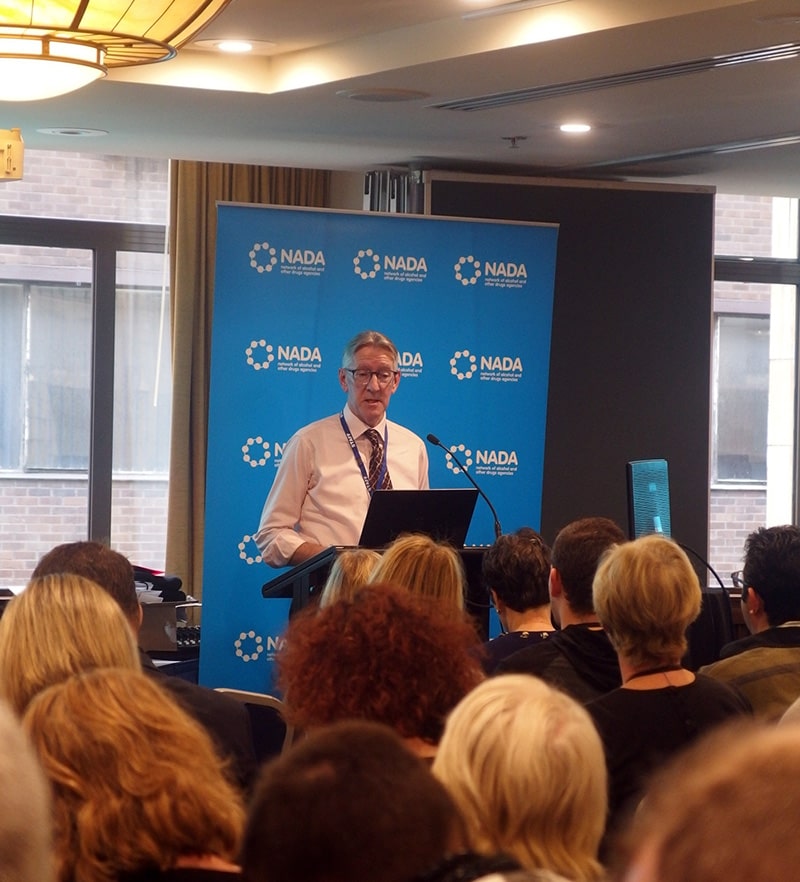International Women's Day
The female experience
Jenny Valentish and Rosemaree Miller, NADA
Source: NADA Advocate
Over the last decade, less than 40% of Australian clients receiving treatment for their own substance use identified as female.¹ On the surface, this uneven ratio of female to male clients could suggest that more men than women experience problematic substance use in Australia. However, a growing body of evidence indicates that there are differences in the experience of problematic substance use for individuals who are female or male.² Moreover, an individual’s gender³, ⁴ may also impact the trajectory of their recovery from problematic substance use.
In her 2017 book, Woman of substances, Jenny Valentish explores the female experience of AOD use. In this research-memoir hybrid, Jenny artfully intertwines discussion of her own experiences with the factors known to contribute to problematic substance use for individuals who identify as women. I sat down with Jenny to discuss some of the social determinants that affect the female experience of AOD use, and how this knowledge can be
used to inform treatment, evidence based practice and research in the non government service sector.
How is the female experience of AOD use unique, and how does this impact women in treatment for problematic substance use?
Experience of trauma ’Nothing is completely unique to women in treatment; however, women are perhaps more likely to have experienced sexual trauma.⁵ So, that means if there are no gender specific treatment options, talking about traumatic experiences in a mixed setting can be uncomfortable for women in treatment.’
Child-care responsibilities ‘Even if a woman is in a stable relationship when she has children, she may still be discouraged from seeking help because of child care responsibilities. A woman could initially engage in treatment, but she may not be able to sustain this if, say, her partner or family are unable to assist with child-care.
Alternatively, she might feel that leaving her children with a partner, or even her family, is not a safe option.
Eating disorders ‘Eating disorders and substance use go hand in hand, especially for women.⁶, ⁷ It’s quite hard to find treatment services that tackle both at once. If these comorbid issues are severe, it can mean that some people may fall between the cracks. Is a detox ward going to take on a client who needs to be properly fed and monitored for their eating disorder? And how likely is it that an eating disorder ward would take on a client who is in withdrawal? In either scenario, the client might feel they have to lie and pretend that the withdrawal, or the eating disorder, isn’t happening, which can be dangerous.’
Stigma around substance use ‘There’s a lot of judgement around female clients, especially mothers, which can lead them to conceal their drug use a lot more. This can create what’s called ‘telescoping’,⁴ when it appears that women become addicted much faster than men. In actual fact, that severity of dependence could be partly because some women conceal their substance use for a longer time before seeking treatment.’
‘Women often present at the pointier end of the issue as they have ‘fallen through the gaps’ and are usually at risk of losing their family. This in turn, increases the stigma felt by our women. We aim to create a warm, welcoming and stable place for her recovery. We work closely with mother and children through age appropriate play, guided psychotherapy and continuous self-reflection. We rebuild wounded relationships, foster healthy attachments and create supportive networks to reduce stigma, enhance wellbeing and improve outcomes for recovery and families.’ Kate Dodd, Phoebe House
What are three ways in which services could better support their female clients in treatment?
Provide gender-sensitive treatment ‘I think there need to be options available for women to seek women-only treatment, and there are options, but there aren’t enough—particularly if you have a child that you need to have with you. It’s harder to find that kind of service. Treatment is usually considered to be gender-neutral, but is this true if the experiences of men are used to judge what is normal?³ Because more men than women are in treatment as a direct result of there being more barriers for women to access treatment than men, so, unfortunately, any statistics you get from treatment services can feed into the old idea that substance use is primarily a male problem.’
Ensure trauma informed care is available ‘Staff would need to understand that women who have reached the stage of needing treatment are very likely to have experienced cumulative trauma.⁸ Not understanding how cumulative trauma works can make it harder for staff to support female clients. Say, if you’ve experienced sexual abuse as a child, and then start using drugs to self-medicate, you might increase your likelihood of being in unsafe situations. This can lead to the mindset where an individual may think they are a bad person, and that bad things always happen to them. When, in fact, the way cumulative trauma works is that when you add something like drug use to the experience of trauma, that itself predisposes an individual to being preyed upon by opportunists and predators.’
Practical support with safety and resources ‘The woman’s safety has to be a priority. Use your discretion and take any safety concerns she may have seriously. Be careful with the privacy of these clients and if there isn’t an option for trauma informed care at your service, then refer the woman to an appropriate service that can provide this care. It is important to make the referral process as streamlined as possible, though. A woman may be juggling child-care with other responsibilities while seeking treatment, and she may not be able to follow up with more than one referral at a time, particularly if she’s being bounced around town.
Summary and next steps
Individuals who identify as women, men or another gender face many of the same challenges when receiving treatment for problematic substance use. However, considering some of the social and practical barriers that women may face in accessing treatment could improve the retention of female clients with your service. You can achieve this by creating an environment in which female clients will be more likely to engage with and continue their treatment.
Jenny Valentish is a freelance journalist and writer who has published three books, including the 2017 ‘Woman of substances’. Jenny is also an ambassador for Monash University’s Brain and Mental Health Laboratory, a board director of SMART Recovery Australia, and the chair of SMART Recovery International’s communications and brand committee
Resources
NADA’s AOD treatment resource
Working with women engaged in AOD treatment
Eating disorders
Butterfly Foundation
The national charity for people impacted by eating disorders
and body image issues, and for those who support them.
Trauma informed care
Blue Knot
National Centre of Excellence for Complex Trauma
1800RESPECT
National sexual assault, domestic family violence counselling service
Rape and Domestic Violence Services Australia
Provides support for people affected by sexual,
domestic or family violence.
Spotlight on trauma informed practice and women
This resource, produced by Women’s Health Victoria,
features a list of up-to-date and freely available research and resources.
Bibliography
1. Australian Institute of Health and Welfare (2020, July 27). Alcohol and other drug treatment services in Australia, 2018–19. AIHW. https://www.aihw.gov.au/reports/alcohol-other-drug-treatment-services/alcohol-other-drug-treatment-services-2018-19/data
2. Sanchis-Segura, C., & Becker, J. B. (2016). Why we should consider sex (and study sex differences) in addiction research. Addiction Biology, 21(5), 995–1006. https://doi.org/10.1111/adb.12382
3. Becker, J. B., McClellan, M., & Reed, B. G. (2016). Sociocultural context for sex differences in addiction. Addiction Biology, 21(5), 1052–1059. https://doi.org/10.1111/adb.12383
4. Zakiniaeiz, Y., & Potenza, M. N. (2018). Gender-related differences in addiction: A review of human studies. Current Opinion in Behavioral Sciences, 23, 171–175. https://doi.org/10.1016/j.cobeha.2018.08.004
5. Moustafa, A. A., Parkes, D., Fitzgerald, L., Underhill, D., Garami, J., Levy-Gigi, E., Stramecki, F., Valikhani, A., Frydecka, D., & Misiak, B. (2018). The relationship between childhood trauma, early-life stress, and alcohol and drug use, abuse, and addiction: An integrative review. Current Psychology. 1-6. https://doi.org/10.1007/s12144-018-9973-9
6. Harrop, E. N., & Marlatt, G. A. (2010). The comorbidity of substance use disorders and eating disorders in women: Prevalence, etiology, and treatment. Addictive Behaviors, 35(5), 392–398. https://doi.org/10.1016/j.addbeh.2009.12.016
7. Robinson, L. D., Kelly, P. J., Deane, F. P., & Reis, S. L. (2019). Exploring the relationships between eating disorders and mental health in women attending residential substance use treatment. Journal of Dual Diagnosis, 15(4), 270–280. https://doi.org/10.1080/15504263.2019.1660019
8. Evidence of an association between the number of traumatic events experienced by an individual and their vulnerability to specific conditions is difficult, as this depends upon how trauma is defined by a particular study and the condition under investigation (e.g., PTSD). In relation to problematic substance use, however, Briere et al. (2010) found that participants were more likely to engage in dysfunctional avoidance the higher the numbers of interpersonal traumas they had
experienced. In this study, dysfunctional avoidance was indexed by substance abuse, suicidality, dissociative behaviours and the use of tension-relieving behaviours to neutralise negative feeling (e.g., selfinjury, food bingeing). Briere, J., Hodges, M., & Godbout, N. (2010). Traumatic stress, affect dysregulation, and dysfunctional avoidance: A structural equation model. Journal of Traumatic Stress, 23(6), 767–774. https://doi.org/10.1002/jts.20578


